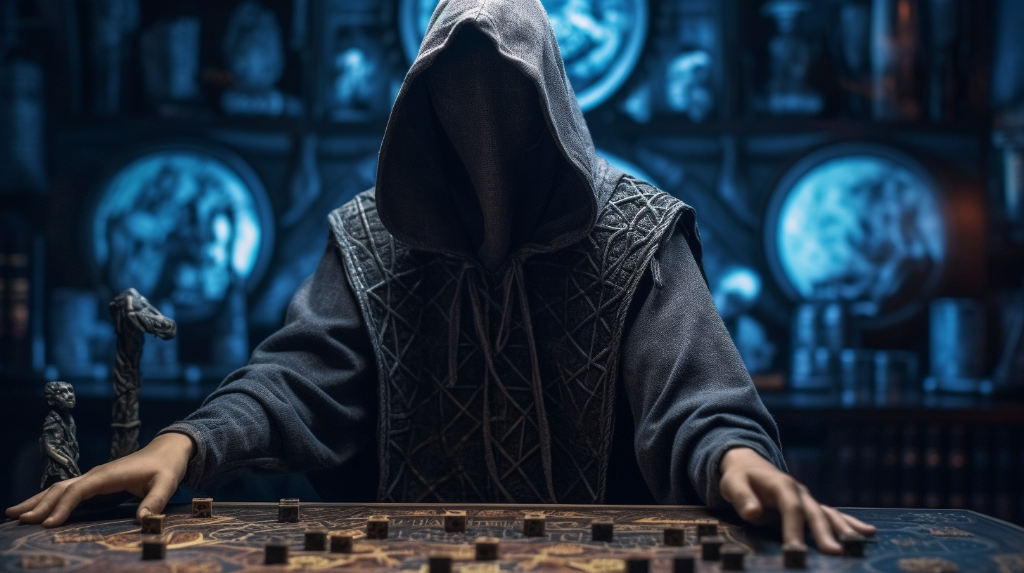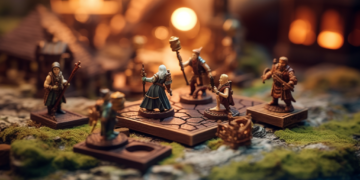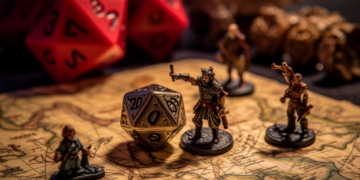
In the captivating and multifaceted world of Dungeons and Dragons 5e, few characters evoke a sense of mystery and trepidation as does a cultist. The word ‘cultist’ conjures images of shadowy figures, whispering sacred incantations under the cloak of darkness, devoted to entities that exist beyond the realm of mortal comprehension. These enigmatic characters, driven by their unwavering faith and obscure motives, are not only a source of intrigue but also a dynamic addition to any campaign.
But what is a cultist in the context of D&D 5e? What dark paths do they tread, and what unique abilities do they wield? Let’s embark on a journey to unveil the secrets of these sinister devotees.
Unveiling the Faces of Cultists
The term ‘cultist’ is a broad brush that paints a plethora of diverse characters in the sprawling canvas of D&D 5e. From the fervent followers of forgotten deities to the zealous servants of eldritch horrors, cultists can serve a myriad of dark entities, each with their unique motivations and goals. What binds them together, though, is their unwavering devotion and the insatiable thirst for power.
Are they merely pawns in a cosmic game, or do they seek to overthrow the established order and usher in a new era of chaos? The answer often lies in the shadowy depths of their hearts, adding layers of complexity to their characters.
The Mechanics of Cultists
The mechanics of a cultist character can be as varied and intricate as their motives. With a myriad of unique abilities, traits, and spells at their disposal, each cultist can pose a unique challenge in a campaign. Understanding these mechanics is crucial, not only for the Dungeon Master who weaves the narrative but also for the players who engage with these characters.
Moreover, the role-playing potential of a cultist character is immense. Their ambiguous morality, coupled with the power they wield, can lead to some of the most compelling narratives. Can they resist the seductive call of the dark powers they serve, or will they succumb to the madness that often follows? Only time will tell.
Mysterious Symbols and Hidden Rituals
What secrets lie beneath the dark robes of the cultist, hidden within the obscurity of their sacred texts and cryptic symbols? As we pull back the velvety, shadow-strewn curtains of the cultist’s world, we find ourselves immersed in a realm of enigmatic symbols and clandestine rituals, each brimming with arcane power and otherworldly intrigue.
Cultist Iconography
Every cult is known by its symbols and signs, the cryptic language of the unseen that speaks volumes about their beliefs and the deities they worship. The serpentine sigil of the Yuan-ti cultists, the fiery emblem of the Elemental Evil, or the blood-drenched runes of the Death domain – each symbol is a key that unlocks the cult’s identity and weaves their thread into the grand tapestry of your campaign’s narrative.
Have you ever pondered how these intricate designs of power can shape the course of your adventures? A mysterious emblem found in the depths of a dungeon, a tattoo on a captured enemy, or an ancient mural in a forgotten temple – these are not mere decorative elements. They are the whispers of a hidden world, waiting to be deciphered by the brave and the curious.
The Power of Rituals
What is a cult without its rituals? The arcane rites and ceremonies of cultists are as essential to their identity as their symbols. Rituals are the conduit through which they channel their devotion, drawing upon the power of their deities or the entities they venerate.
From the midnight sacrifices of the Cult of Orcus to the trance-like dances of the Siren’s Song cult, each ritual is a living narrative, a piece of the campaign’s heartbeat that can influence its course and provide exciting, chilling challenges for the players. Can you imagine the thrill of interrupting a ritual just in time, or the horror of arriving too late? The possibilities are endless, and they lie in your hands.
Power or Madness – The Cultist’s Path
Being a cultist is not an easy path. It’s a journey shrouded in shadows, a tightrope walk between power and madness. As a player, the role of a cultist offers an abundance of opportunities for profound moral and ethical dilemmas. How far will you go for power? What sacrifices are you willing to make?
Imagine a cultist character torn between their loyalty to their cult and their affection for their adventuring companions. Or the internal struggle of a cultist who begins to question the doctrines they have been taught to believe. The cultist’s path is a thrilling, perilous journey that demands courage, cunning, and a constant dance with the unknown.
Encountering a Cultist – A DM’s Guide
Ever thought about how to introduce a cultist into your campaign? The presence of a cultist can add an unexpected twist to your adventure, stirring up unease and tension among your players. A cultist, with their cryptic rituals and dark motivations, can be an intriguing adversary or a dubious ally.
When incorporating a cultist into your campaign, consider their motivations. Are they a fanatic servant of a dark deity, or a misunderstood zealot seeking a higher purpose? Their goals and methods can vary, adding layers of complexity to the campaign.
Remember, the cultist should not only be a challenge in combat but also a puzzle to unravel. Their actions should be shrouded in mystery, their motives enigmatic. This will keep your players on their toes, always guessing what their true intentions might be.
The cultist’s abilities and stats are essential elements to consider. They can drastically affect the course of the game and the strategies your players will need to employ.
| Cultist | Abilities | Stats |
|---|---|---|
| Cult Fanatic | Dark Devotion, Spellcasting | STR 11, DEX 12, CON 12, INT 10, WIS 13, CHA 14 |
| Cult Leader | Channel Divinity, Divine Eminence, Spellcasting | STR 16, DEX 14, CON 16, INT 14, WIS 18, CHA 20 |
| Cult Acolyte | Spellcasting | STR 10, DEX 10, CON 10, INT 10, WIS 14, CHA 11 |
Role-playing a Cultist – Unleashing the Unseen
Have you ever imagined what it might be like to play a character on the darker side of the moral spectrum? Role-playing a cultist character is not for the faint-hearted. It requires stepping into the shoes of a character who is often misunderstood, feared, or even reviled.
When playing a cultist, it’s crucial to maintain a sense of mystery and unpredictability. Your alignment, your motivations, even your spells and abilities should keep other players guessing. Remember, as a cultist, you are not merely a character, but a force that adds depth and intrigue to the storyline.
It’s also essential to consider your cultist’s backstory. What led them to join a cult? What are their ultimate goals? This backstory will not only shape your character’s actions but also provide a foundation for their development throughout the campaign.
Notable Cultist Figures in D&D History
Throughout the rich lore of Dungeons & Dragons, there have been many memorable cultist figures. These characters, with their compelling backstories and complex motivations, have left a lasting impact on the world of D&D.
- Tharizdun: Known as the Chained God, Tharizdun is worshiped by many cults who seek to bring about his return and the end of the world.
- Exethanter: Once a member of the liches’ cult known as the Circle of Eight, Exethanter lost his memory and now serves as a guide in the megadungeon of Undermountain.
- Severin Silrajin: As the leader of the reformed Cult of the Dragon, Severin aimed to free the dragon goddess Tiamat from her prison in the Nine Hells.
Building Your Cultist – A Character Creation Guide
Are you ready to immerse yourself in the shadowy world of cultists? Let’s embark on the journey of creating a compelling cultist character. Remember, it’s not just about the stats and abilities; your character’s backstory, motivation, and alignment will be the driving force behind your cultist’s actions.
Step-by-Step Guide to Creating a Cultist Character
- Step 1: Choose your race. While humans are a common choice due to their versatility, other races like tieflings or drow might lend themselves to the cultist’s narrative.
- Step 2: Decide on a class. While warlocks might seem like the obvious choice, don’t be afraid to think outside the box. A rogue, bard, or even a cleric can make for an intriguing cultist.
- Step 3: Create your character’s backstory. Were they born into the cult, or did they join willingly? What dark secrets do they hold?
- Step 4: Determine your cultist’s motivation. Are they seeking power, enlightenment, or perhaps revenge?
- Step 5: Define their alignment. Cultists can range from chaotic evil to lawful neutral, depending on the deity they worship and their personal motivations.
- Step 6: Equip your character. A cultist’s gear can be as unique as the character themselves, often reflecting the rituals and beliefs of their cult.
- Step 7: Finally, flesh out your character’s personality traits, ideals, bonds, and flaws. These will greatly influence how your character interacts with the world and the other players.
The Dark Allure – Why Play a Cultist?
So why would anyone choose to play a cultist in D&D? Quite simply, the allure lies in the complex narrative possibilities and character development that a cultist can bring to the table. Can you imagine the intrigue and suspense of weaving a web of deception, as your party slowly uncovers your true allegiance? Or the drama and tension of wrestling with your character’s faith and devotion as they are confronted with the dark realities of their cult?
Playing a cultist is not for the faint-hearted. It’s for those who crave depth, complexity, and a dash of moral ambiguity in their role-playing experience. It’s for players who are not afraid to venture into the shadows, to question the nature of faith and power, and to explore the darker side of the D&D universe.
So, are you ready to embrace the dark allure of the cultist? Remember, as you step into this new role, that you’re not just playing a character. You’re crafting a story, one that’s filled with mystery, suspense, and maybe even a little bit of treachery. So, let the game begin.






